Behind the Funeral Home Doors: The Reality of a Mortician's Day
A day in the life of a mortician typically involves a blend of technical tasks and compassionate family support. For those seeking a quick understanding:
| Time | Common Mortician Activities |
|---|---|
| Early Morning | Checking overnight calls, preparing paperwork, body pickups |
| Mid-Morning | Embalming, restoration work, meeting with families |
| Afternoon | Arranging funeral logistics, coordinating with clergy/vendors |
| Evening | Overseeing viewings/services, on-call duties |
| Overnight | Emergency removals (on rotation) |
The clock often strikes as early as 6:30 AM for these death care professionals, who balance scientific precision with artistic restoration and emotional support. Unlike the grim stereotypes portrayed in movies, morticians find their work deeply rewarding as they help families through their most difficult moments.
"Most of your work as a funeral director isn't actually with the deceased, but rather tending to the needs of their families," notes one professional with over 17 years of experience. This human-centered approach defines the profession, even as morticians handle the technical aspects of preparation and preservation.
No two days are identical in this field. A mortician might begin by checking the log book for overnight deaths, then transition to embalming or restoration work, meet with grieving families to plan services, coordinate with cemeteries or crematories, and finally oversee a funeral or memorial service—all while remaining on call for new cases.
I'm Mortuary Cooler, a national-level supplier of mortuary cooling systems who has witnessed how the right equipment supports morticians throughout a day in the life of a mortician, from body preservation to dignified final arrangements.
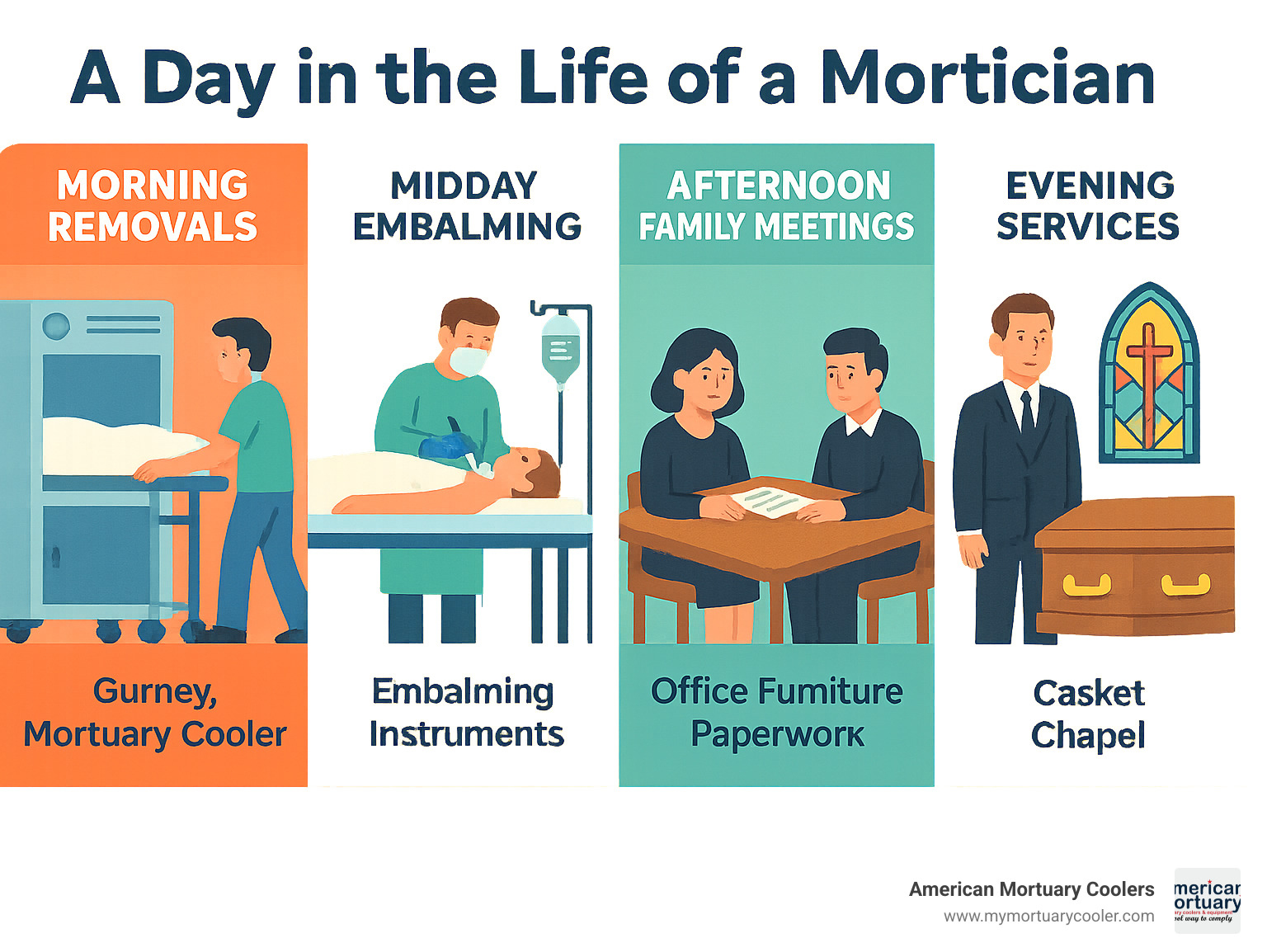
Quick a day in the life of a mortician terms:
The Morning Shift: Where a Day in the Life of a Mortician Begins
For most morticians, dawn doesn't signal the start of work—their day often begins whenever the phone rings. That 3 AM call isn't just a possibility; it's a regular part of a day in the life of a mortician, where death respects no business hours or personal schedules.
"I've answered calls at every hour imaginable," shares one funeral director with a wry smile, running her hand through slightly disheveled hair. "Eventually, you develop a system—function on fragmented sleep, keep a ready bag by the door, and never underestimate the power of good coffee."
The morning often starts with what industry professionals call a "first call" or "removal"—the solemn task of bringing someone who has died into the funeral home's care. This might happen at a hospital corridor, a quiet nursing home room, a family's living room, or sometimes from the medical examiner's facility.
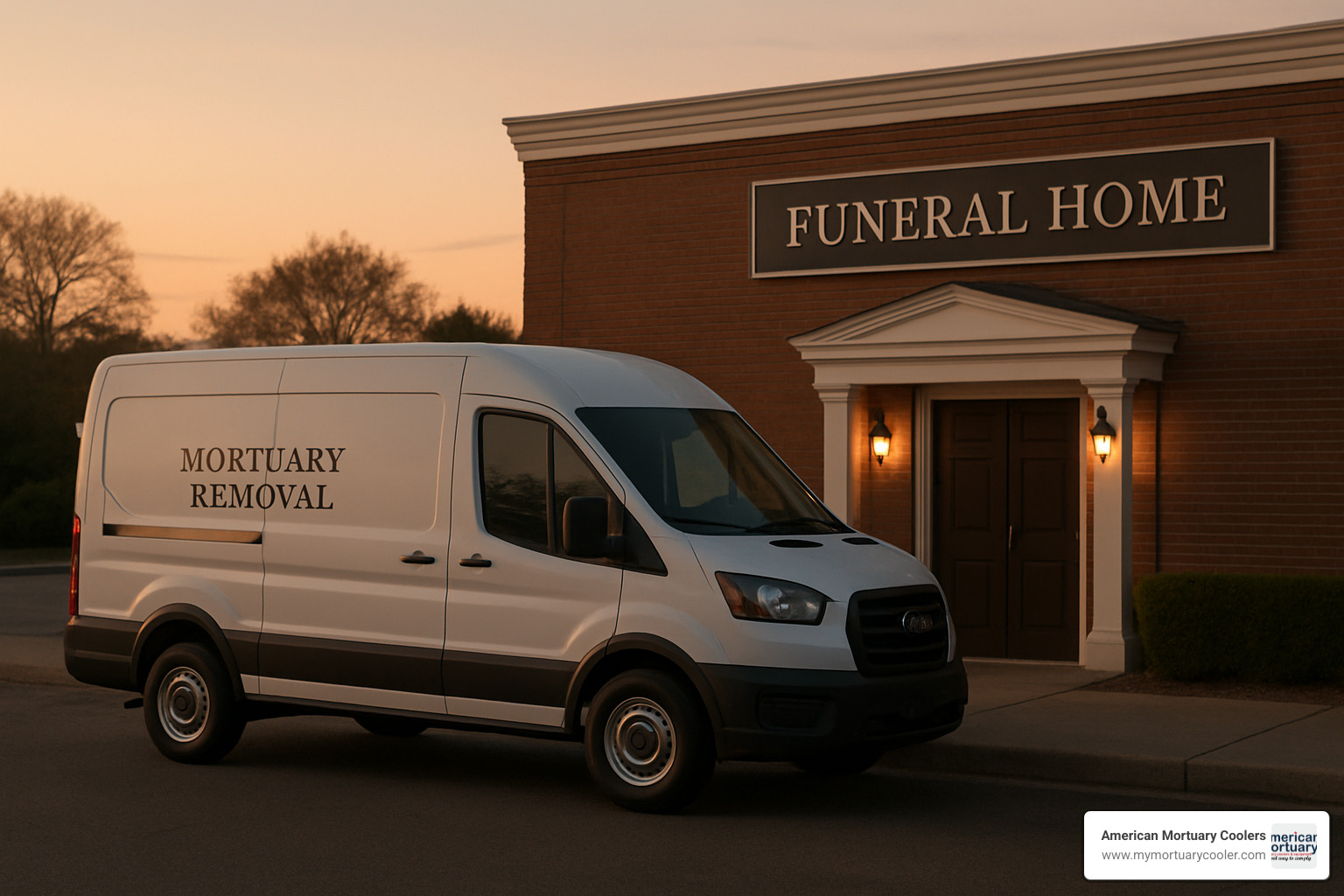
At American Mortuary Coolers, we've heard countless sunrise stories from our clients—from small-town funeral homes in Johnson City, Tennessee to busy urban establishments in Los Angeles. The equipment used during these early hours isn't just practical; it's essential for maintaining dignity and respect during life's most vulnerable moments.
Answering the First Call
That initial phone conversation sets the foundation for everything that follows. The mortician's voice becomes a lifeline for someone experiencing shock, confusion, or overwhelming grief. They must balance compassion with practicality, gathering necessary information while acknowledging the raw emotions on the other end of the line.
When death occurs at someone's home, morticians arrive promptly with a carefully prepared kit: a removal stretcher designed for tight spaces, appropriate body coverings, personal protective equipment, identification materials, and necessary paperwork. The modern mortician is part logistics expert, part counselor.
"When I step through someone's front door for a removal, I'm walking into what might be the worst day of their lives," explains a mortician from Nashville with gentle eyes. "How I carry myself—my words, my body language, even the way I handle their loved one—can deeply impact their healing journey."
The technical aspects of navigating narrow hallways or steep stairs with a stretcher require physical skill, while simultaneously supporting family members demands emotional intelligence that no textbook fully teaches.
Transportation & Chain of Custody
Contrary to popular belief, the iconic hearse rarely makes an appearance for initial removals. Most funeral homes use specially equipped vans or SUVs—practical vehicles with tinted windows, removable rear seating, and flat loading areas designed for dignity and discretion.
Once the deceased is secured for transport, proper identification becomes the mortician's highest priority. The meticulous system of ID tags, paperwork verification, and sometimes photographic documentation ensures there are no mistakes in the chain of custody.
"We have multiple checkpoints for identification," explains a funeral director from our Atlanta service area, her expression serious. "From the moment we take someone into our care until their final disposition, we're constantly verifying identity. There's simply no room for error."
Upon arrival at the funeral home, the deceased is carefully transferred to a refrigerated holding area. Our custom-designed mortuary coolers maintain the precise temperature range of 35-40°F—cold enough to slow natural processes without freezing tissues, which would complicate embalming later.
These specialized coolers feature reinforced rollers for smooth transfers and seamless interiors that prevent contamination while making thorough sanitization straightforward. For those interested in learning more about available options, our comprehensive guide to mortuary cold storage options provides detailed information.
Morning Administration
With the deceased secure, a day in the life of a mortician shifts to crucial paperwork—the invisible framework that supports every aspect of death care:
Death certificates need accurate completion, doctors' signatures must be obtained, permits filed with vital records offices, and burial or cremation authorizations verified. The mortician coordinates facilities, staff schedules, and arrangements with cemeteries or crematories, all while navigating a complex web of regulations.
The FTC Funeral Rule provides important consumer protections, mandating specific disclosures and prohibiting certain practices. Morticians must know these regulations inside and out.
"The paperwork might seem like the least important part of what we do," notes a Chicago-based mortician who's worked with our cooling systems for years. "But in reality, it's critical. One mistake on a death certificate can cascade into delays and additional heartache for families already going through enough."
He adds with a gentle smile, "The morning hours set the tone for everything that follows. When we get this part right—from that first compassionate phone call to properly filed paperwork—we create space for families to begin their grief journey with one less burden."
Inside the Prep Room: Science, Art, and Equipment
The preparation room is where the magic happens in a day in the life of a mortician. This specialized space, tucked away from the public areas of the funeral home, serves as both laboratory and studio where technical skill meets compassionate artistry.
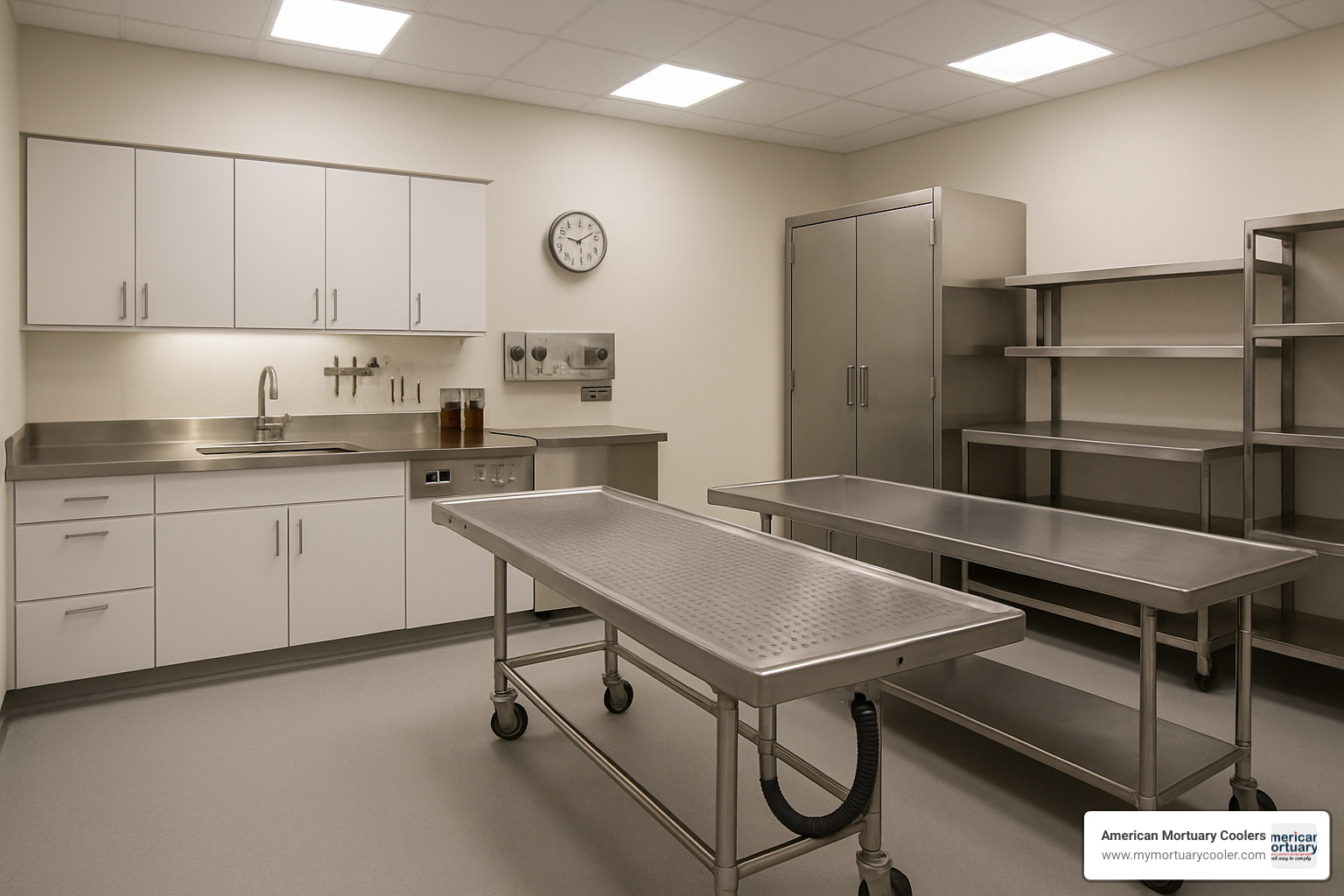
"The prep room is where science and art converge," shares a mortician with 26 years of experience who has gently cared for over 1,000 deceased individuals. "It's where we transform someone who may have been ill or injured into a peaceful version of themselves that brings comfort to their family."
We at American Mortuary Coolers have walked through countless prep rooms across the country, from small family-owned funeral homes in rural Tennessee to large metropolitan facilities in Chicago. We've seen how the right equipment creates the foundation for the deeply meaningful work that happens here.
Embalming 101 — A Core Task in a Day in the Life of a Mortician
While not universally performed (some religious traditions prohibit it, and it's not necessary for immediate cremation), embalming remains a cornerstone skill for most morticians.
The process begins with gentle cleansing and disinfection, followed by the careful injection of formaldehyde-based solution into the arterial system while blood is respectfully drained. The mortician then performs cavity embalming, where internal fluids are removed and preservative chemicals introduced. Finally, the deceased is bathed again, dressed in clothing provided by the family, and cosmetics are applied to create a natural, peaceful appearance.
"Embalming became widespread during the Civil War," a funeral historian from our New York service area told us once over coffee. "When President Lincoln viewed an embalmed soldier and noted how natural he appeared, it helped normalize the practice across America."
Each case requires adjustments based on the unique circumstances—the person's medical history, cause of death, and time elapsed since passing all influence the techniques used. For those curious about the technical aspects while respecting the dignity involved, we've created A Guide to the Embalming Process Explained.
Cold Storage & Equipment Essentials
Proper refrigeration isn't just important—it's essential in modern funeral service. Our team at American Mortuary Coolers provides customized solutions ranging from compact single-body units to spacious walk-in systems for larger facilities.
The well-equipped prep room includes more than just cooling systems. Hydraulic embalming tables provide adjustable height and proper drainage. Body lifts help morticians safely transfer the deceased with dignity. Aspirating devices and arterial injectors allow for precise chemical application. Scissor carts enable gentle transport within the facility, while organized instrument trays keep tools accessible.
"Having reliable equipment makes all the difference in our day," a mortician from Dallas told us while installing his new cooler system. "When you're working with grieving families on tight timelines, equipment failures simply aren't an option."
That's why our mortuary coolers feature redundant cooling systems, backup power options, and remote temperature monitoring—because we understand that reliability isn't just convenient, it's crucial. From Pittsburgh to Los Angeles, we deliver directly to funeral homes across the contiguous 48 states, ensuring professionals everywhere have access to dependable equipment.
For a deeper look at prep room design and equipment, check out our article on the ins and outs of funeral home prep rooms.
Personal Protective Equipment & Safety
Safety in the prep room isn't negotiable. Morticians protect themselves with nitrile gloves (often doubled), fluid-resistant gowns, face shields, respirators when working with formaldehyde, and disposable sleeves and shoe covers.
OSHA regulations provide important guardrails for mortuary work, particularly regarding bloodborne pathogens and chemical exposure. Well-designed prep rooms include proper ventilation systems, easily accessible eyewash stations, and clearly marked sharps disposal containers.
A mortuary science instructor I met at a trade show put it perfectly: "People don't realize how much science and safety training goes into becoming a mortician. We're handling chemicals, bloodborne pathogens, and sometimes infectious diseases. Proper protocols aren't just bureaucratic requirements—they're what keep us healthy so we can continue serving families."
The National Funeral Directors Association regularly updates their trends in funeral service to reflect evolving best practices in preparation room safety and technology, showing how the profession continues to advance while honoring timeless traditions of care.
Supporting Families: Arrangements, Rituals, and Services
Beyond the technical side of mortuary science lies what many consider the heart of a day in the life of a mortician: working directly with grieving families. These interactions require a delicate balance of compassion and professionalism that can't be taught in textbooks alone.
"When I sit down with a family, I'm not just selling services," shares a funeral director from our Southeast Region. "I'm helping them create a meaningful tribute that honors their loved one and gives them a foundation for healing."
These conversations often take place in specially designed arrangement rooms – comfortable, homelike spaces where families can feel at ease during what might be one of the most difficult conversations of their lives.
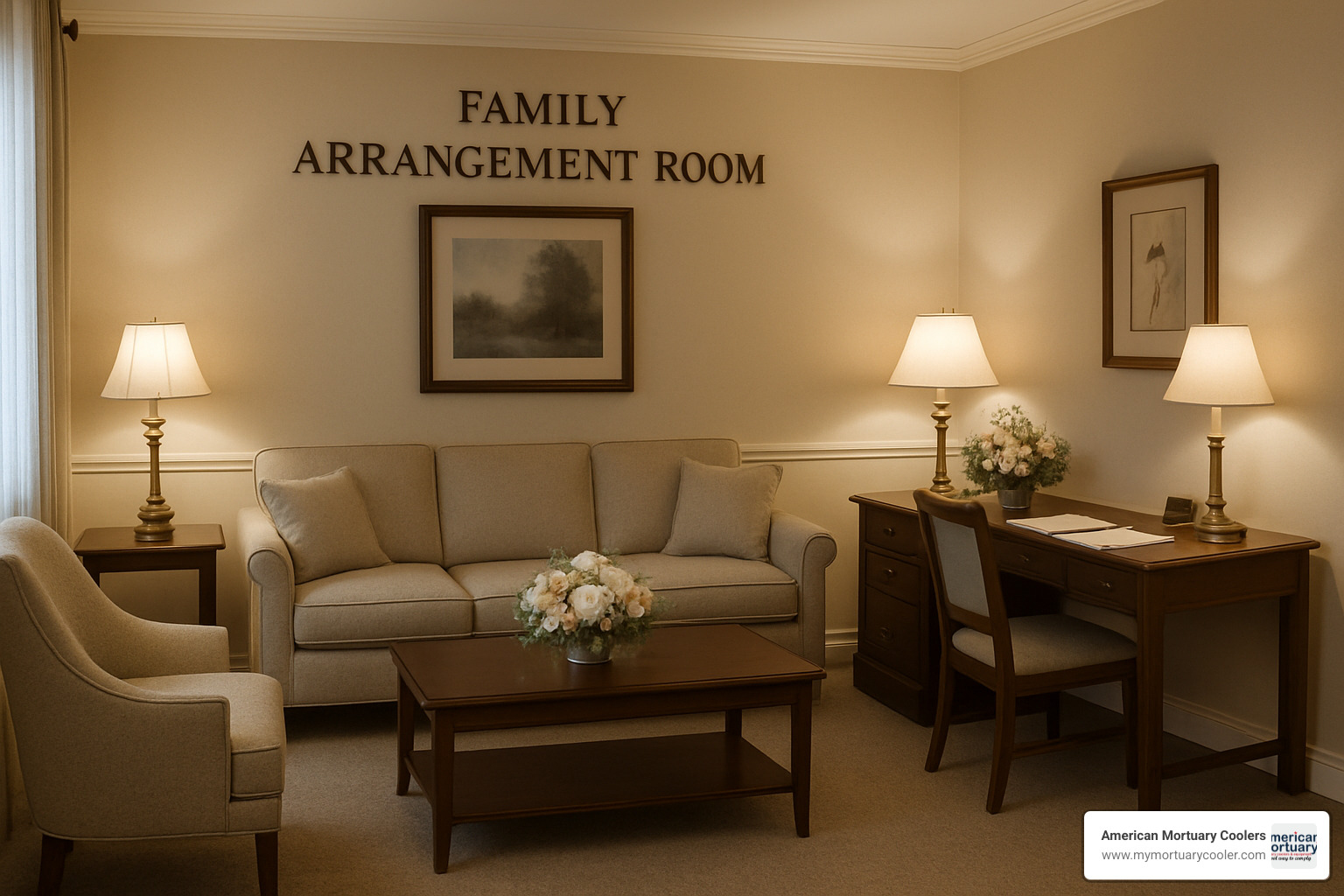
From Paperwork to Personalization
Today's arrangement conferences have evolved dramatically from the cookie-cutter services of yesteryear. Modern morticians guide families through an expanding array of options, each requiring different paperwork, timelines, and considerations.
"Families often don't know what's possible," explains a funeral director from Columbia, SC. "Part of my job is educating them about options they might not have considered, from eco-friendly choices to personalization elements that reflect their loved one's passions."
These options now include traditional burial with viewing, direct cremation, green burial, aquamation (alkaline hydrolysis), and even human composting (natural organic reduction) where legally permitted. With each choice, morticians must remain sensitive to cultural and religious preferences while ensuring all legal requirements are met.
The paperwork alone can be overwhelming for grieving families – obituary information, music selections, casket or urn choices, flower preferences, and payment arrangements. A skilled mortician transforms this potentially overwhelming process into a healing journey.
Personalization has become increasingly important in modern funeral service. Morticians help families incorporate meaningful touches like custom music playlists, memory tables with personal items, video tributes, services themed around hobbies or interests, and even customized caskets or urns.
Scientific research supports the value of these personalized elements. According to studies cited by the National Funeral Directors Association, meaningful rituals provide significant psychological benefits for those navigating grief.
The Service Day
On the day of a funeral or memorial service, morticians transform into event coordinators and masters of ceremonies. Their behind-the-scenes work ensures everything runs smoothly while families can focus on their grief and remembrance.
"Service days are physically and emotionally demanding," notes a funeral director from our Midwest Region. "You're constantly moving between public-facing roles and behind-the-scenes logistics, all while maintaining a calm, compassionate presence."
This juggling act includes arranging the deceased for viewing, setting up flowers and memorial items, testing audio/visual equipment, coordinating with clergy or celebrants, managing visitor flow, directing pallbearers, and overseeing processions to cemeteries.
Technology has added new dimensions to funeral service. Many morticians now manage livestreaming equipment for virtual attendance, ensuring that distant family members can participate in the ritual of saying goodbye. At American Mortuary Coolers, we understand that reliable equipment – from body coolers to livestreaming setups – is essential for these meaningful moments to proceed without disruption.
Throughout these services, the mortician remains vigilant, anticipating needs and addressing issues before families notice them. A box of tissues appearing just when needed, a gentle redirection when emotions run high, or a supportive arm for an elderly mourner – these small gestures reflect the mortician's commitment to supporting families through their darkest hours.
Community Outreach & Education
Many morticians extend their care beyond individual families to broader community education. These efforts help normalize conversations about mortality and explain the funeral profession.
"There's still so much mystery and misinformation around what we do," explains a mortician who regularly hosts open houses. "By being transparent about our processes, we help people become more comfortable with death as a natural part of life."
These outreach efforts take many forms: hosting "Death Café" discussions where people can openly discuss mortality, offering mortuary tours for healthcare professionals, speaking at schools about funeral service careers, and creating social media content to dispel myths about death care.
Some funeral homes even partner with local hospices to provide pre-need planning workshops or grief support groups. These connections strengthen community ties while providing valuable education about end-of-life matters.
At American Mortuary Coolers, we're proud to support funeral professionals across the country with the reliable equipment they need for every aspect of family care. Our Essential Funeral Home Refrigerator guide explains why dependable equipment forms the foundation of exceptional funeral service.
After Hours & Work–Life Balance in a Day in the Life of a Mortician
When the lights dim at most businesses, a day in the life of a mortician often continues well into the evening. The reality? Most funeral professionals wave goodbye to the standard 40-hour workweek, with many logging 50-60 hours as their normal routine.

"The joke at our firm is 'We doze but we don't close,'" shares a funeral director from our Rocky Mountain service area with a tired smile. "Death doesn't check the clock before happening, so someone's always on call. During busy periods—like flu season or summer heat waves—we all work extended hours."
This unpredictable rhythm creates unique challenges for personal life. Birthday parties get missed. Date nights get postponed. And that long-awaited vacation? It might get cut short by an emergency call. Morticians become masters at juggling their professional responsibilities with their need for rest and family time.
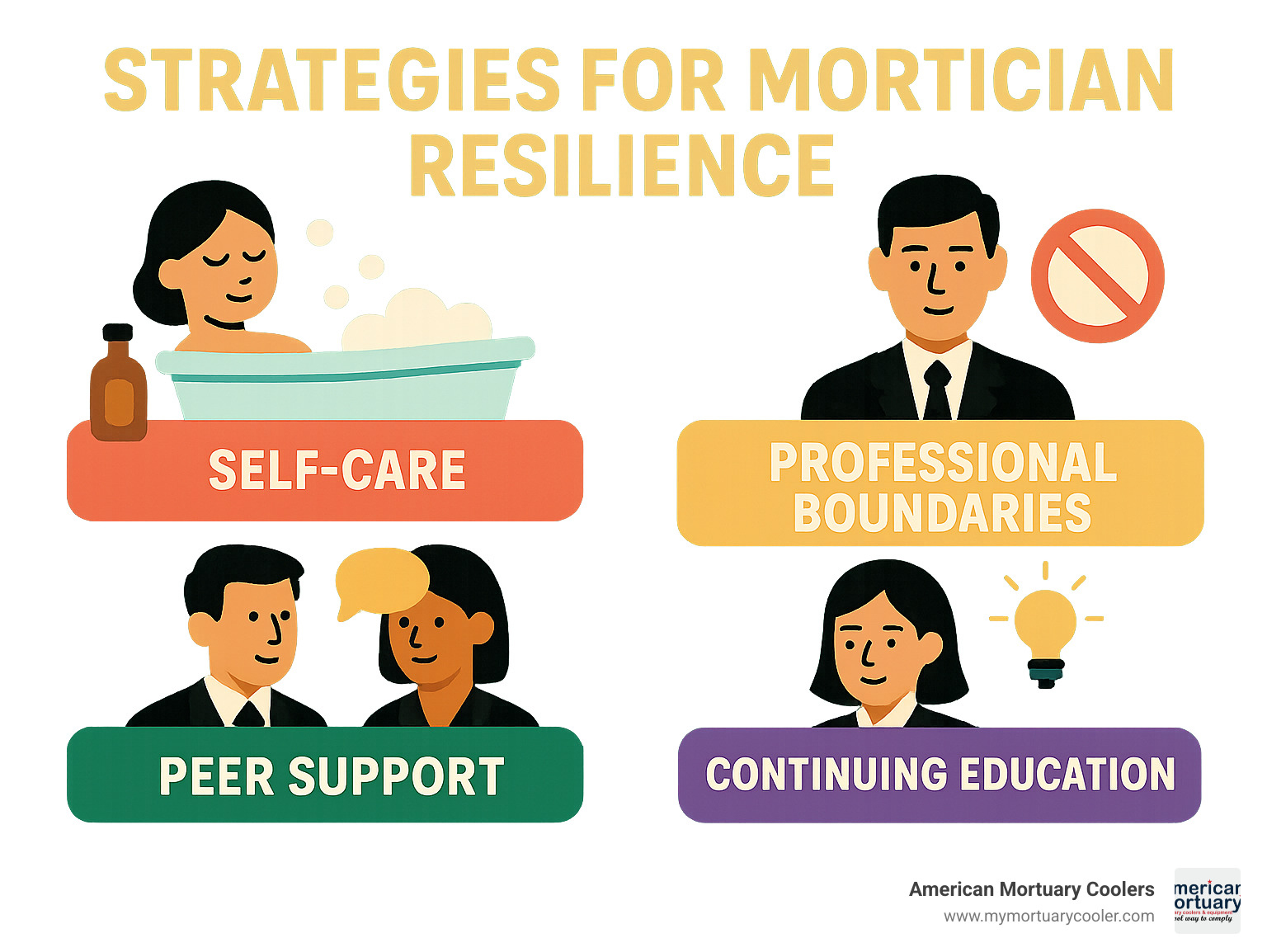
Coping with the Emotional Toll of a Day in the Life of a Mortician
The weight of grief work is substantial. Imagine spending your Tuesday morning helping a mother select a casket for her teenage son, your afternoon preparing a body disfigured by cancer, and your evening comforting a widower who doesn't know how to tell his children their mom is gone.
"You can't pour from an empty cup," a veteran funeral director tells me, her eyes reflecting years of both compassion and careful self-preservation. "Finding ways to process and release the emotional weight of this work isn't optional—it's essential for staying in this profession long-term."
Many morticians develop personal rituals to mark the transition from work to home. Some change clothes immediately upon returning home. Others take a shower to symbolically "wash away" the workday. Many find solace in quiet moments of reflection, journaling, or meditation.
Professional support has become more common too. Funeral homes increasingly recognize the importance of staff mental health, implementing formal support systems like peer debriefing sessions after difficult cases, rotation schedules ensuring adequate rest between on-call shifts, and even covering therapy as part of employee benefits.
Pros, Cons, and Industry Trends
The funeral profession offers deep rewards alongside its challenges. On the positive side, morticians repeatedly mention the profound satisfaction of helping families through their darkest hours. The work provides rock-solid job security (the Bureau of Labor Statistics projects about 5,700 job openings annually through 2031) and a respectable median annual salary of $51,570, with funeral home managers earning around $72,110.
The varied nature of the work appeals to many—one day might involve embalming, the next arranging flowers, and the next counseling a family. Many morticians take pride in becoming trusted community resources during life's most difficult transitions.
The challenges, however, are significant. The irregular hours and constant on-call responsibilities strain relationships. The emotional intensity can lead to compassion fatigue. The physical demands of body handling take a toll on the back and joints. And despite their essential role, morticians often face social stigma and misconceptions about their profession.
The industry itself is evolving rapidly. Women now represent approximately 60% of mortuary science students, dramatically shifting what was traditionally a male-dominated field. Cremation has surpassed burial as America's preferred disposition method, while eco-conscious options like green burial, aquamation, and human composting gain traction.
Technology has transformed funeral service too. Virtual planning meetings, livestreamed memorial services, and digital memorials have become standard offerings. Meanwhile, family-directed funerals and boutique funeral services increasingly challenge the corporate funeral home model.
At American Mortuary Coolers, we're evolving alongside these trends. Our equipment designs now support specialized cooling needs for green burial preparation, and we offer compact, energy-efficient units perfect for boutique establishments. We understand that reliable equipment is one less thing our hardworking mortician clients need to worry about during their demanding days—and often equally demanding nights.
Frequently Asked Questions about Becoming and Being a Mortician
What Training & Licensing Are Required?
So you're curious about joining the funeral profession? The path to becoming a mortician is structured and requires dedication, but it's accessible to anyone with compassion and determination.
Most funeral professionals start with an associate or bachelor's degree in mortuary science from a program accredited by the American Board of Funeral Service Education (ABFSE). These programs blend science courses like anatomy and embalming chemistry with business classes and psychology.
"The education never stops," shares a mortuary science instructor who's trained hundreds of future funeral directors. "Between continuing education requirements and constantly evolving regulations and technologies, this is a profession of lifelong learning."
After completing your education, you'll need to pass the National Board Examination, which tests your knowledge in both the Arts (funeral directing, ethics, psychology) and Sciences (embalming, restorative art, pathology) sections.
Next comes the apprenticeship – a hands-on learning period lasting 1-2 years where you'll work alongside experienced professionals. Many students find this the most valuable part of their training, as it bridges classroom theory with real-world application.
Finally, you'll need to meet your state's specific licensing requirements, which typically include a state law exam. Once licensed, you'll maintain your credentials through regular continuing education – usually about 12 credits per licensing cycle.
Prospective morticians can explore accredited programs through the ABFSE directory, with options available across the country.
What Are the Biggest Misconceptions?
When I tell people what I do at dinner parties, I often hear the same myths about funeral service. Let me set the record straight on a few common misconceptions:
"Funeral homes make enormous profits" is perhaps the most persistent myth. While the profession offers stable employment, many entry-level positions start at modest salaries, and funeral homes operate on tighter margins than most people assume. The average funeral home serves fewer than 150 families annually, with significant overhead costs.
Many people believe embalming is legally required – it's not! Except in rare circumstances (like interstate transportation of remains), embalming is a family choice, not a legal mandate. Many alternatives exist, especially for those choosing immediate cremation or green burial.
The "creepy mortician" stereotype couldn't be further from reality. "We're community-focused professionals who happen to have specialized training in death care," explains a funeral director from our Northeast Region. Most funeral professionals are drawn to the field out of compassion and a desire to help others during difficult times.
Perhaps most importantly, morticians don't primarily work with the dead. The majority of our time is spent with living families – arranging services, providing grief support, handling paperwork, and coordinating events. We're counselors, event planners, and administrators who happen to have specialized knowledge of death care.
How Is the Funeral Industry Changing?
The funeral profession is experiencing fascinating changes that reflect broader shifts in American culture and values.
Cremation now accounts for over 50% of dispositions nationally, a complete reversal from just a few decades ago. This shift is driving funeral homes to redesign their facilities and service offerings. Alongside this trend, green alternatives like natural burial, aquamation, and even human composting are gaining traction among environmentally conscious consumers.
Speaking of aquamation (alkaline hydrolysis), this water-based alternative to flame cremation is being legalized in more states each year. It uses about 90% less energy than traditional cremation and produces no direct emissions.
The profession itself is undergoing a demographic change. With women now representing approximately 60% of mortuary science students, the historically male-dominated field is evolving in its workplace culture and client interactions.
Technology has revolutionized how we serve families. Livestreamed services became essential during the pandemic and remain popular for including distant relatives. Digital planning tools, online memorials, and even AI-generated obituaries are becoming commonplace.
Perhaps most significantly, consumer expectations have fundamentally shifted. "The funeral home of the future will look very different," notes an industry consultant we work with. "More flexible spaces, fewer formal chapels, better digital integration, and more environmentally conscious options."
At American Mortuary Coolers, we're witnessing these changes as funeral homes across our service regions adapt their facilities and equipment needs to meet these evolving consumer preferences. Our cooling systems are designed with these trends in mind, providing the flexibility and reliability that modern death care demands.
Conclusion
A day in the life of a mortician truly represents one of the most diverse and demanding professional journeys imaginable. From those pre-dawn removal calls to evening family arrangements, these dedicated professionals blend scientific knowledge, artistic skill, and heartfelt compassion in ways few other careers require.
Behind every dignified funeral service stands not just talented professionals, but reliable equipment that supports their sacred work. Here at American Mortuary Coolers, we take pride in creating the dependable cooling solutions that morticians across the country rely on daily. Whether you're working in a small-town Tennessee funeral home or a busy Los Angeles mortuary, our custom-designed coolers become silent partners in your commitment to excellence.
We've seen how the right equipment makes all the difference during those crucial hours after a loved one comes into your care. Our mortuary coolers aren't just metal boxes—they're carefully engineered systems that maintain perfect preservation conditions while fitting seamlessly into your unique workspace and workflow.
The funeral profession continues evolving in remarkable ways—from the rise of green disposition options to the integration of livestreaming technology. Through it all, we remain committed to supporting the professionals who guide families through their darkest hours with both technical precision and human warmth.
For those interested in learning more about how our cooling solutions support every stage of a day in the life of a mortician, we invite you to explore our detailed guide to mortuary coolers.
When you meet a funeral director or mortician, you're encountering someone who has chosen a path of service that few could steer—a professional who has mastered both the science of preservation and the art of compassion. Their work matters deeply, and so does the equipment that helps them fulfill their calling with dignity and grace.
From our workshop in Tennessee to funeral homes across all 48 contiguous states, American Mortuary Coolers stands ready to support the quiet heroes who help us all say our final goodbyes.
















